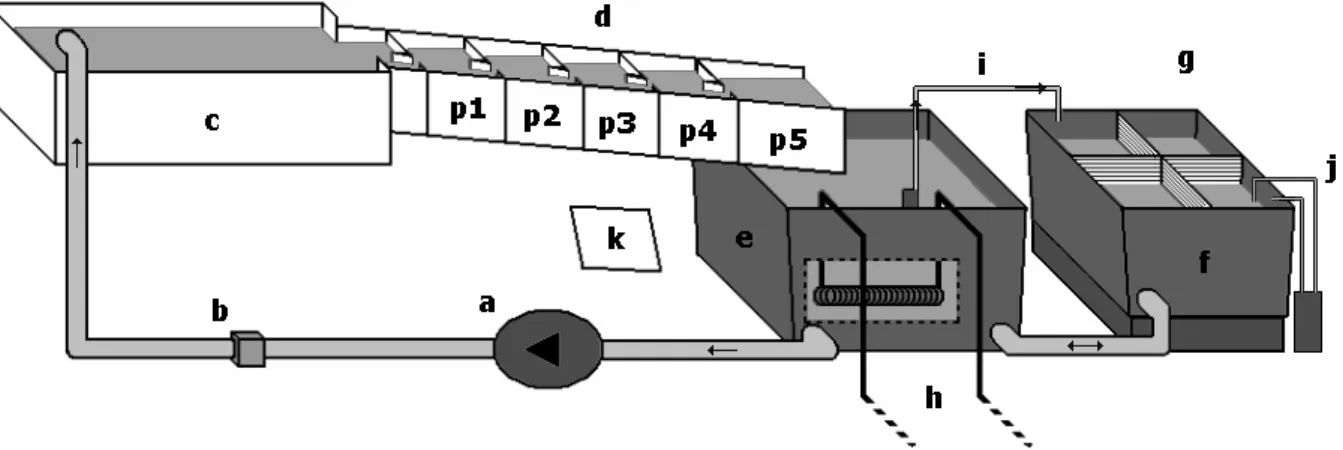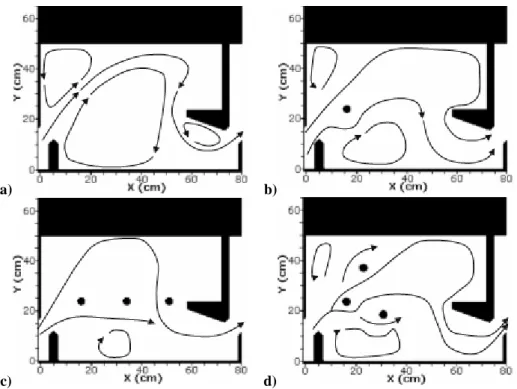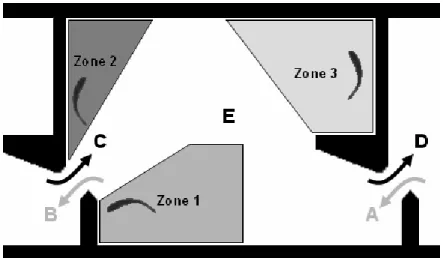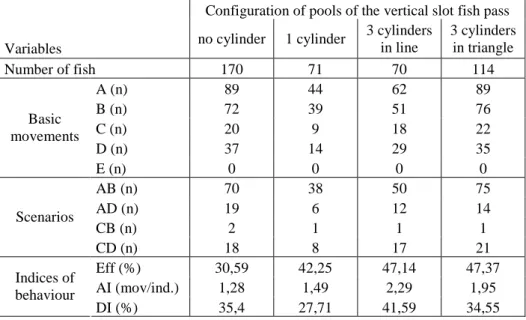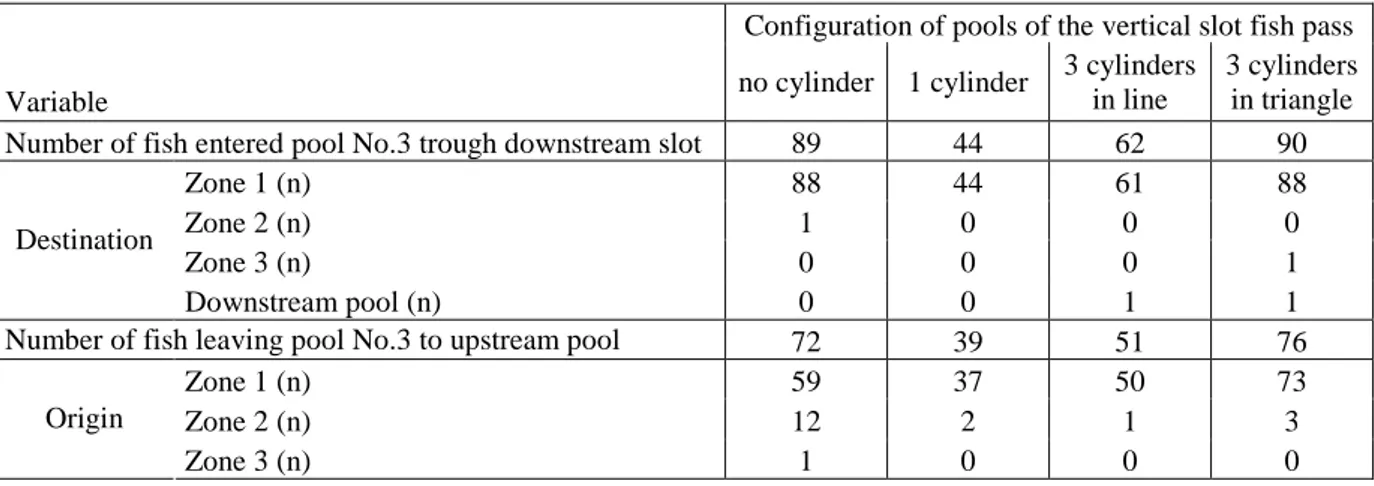Open Archive TOULOUSE Archive Ouverte (OATAO)
OATAO is an open access repository that collects the work of Toulouse researchers and
makes it freely available over the web where possible.
This is an author-deposited version published in :
http://oatao.univ-toulouse.fr/
Eprints ID : 11268
To cite this version : Cornu, Vincent and Baran, Philippe and Damien,
Calluaud and David, Laurent Effects of various configurations of
vertical slot fishways on fish behaviour in an experimental flume.
(2012) In: 9th International Symposium on Ecohydraulics - ISE 2012,
17 September 2012 - 21 September 2012 (Vienne, Austria)
Any correspondance concerning this service should be sent to the repository
administrator:
staff-oatao@listes-diff.inp-toulouse.fr
EFFECTS OF VARIOUS CONFIGURATIONS OF VERTICAL SLOT FISHWAYS
ON FISH BEHAVIOUR IN AN EXPERIMENTAL FLUME
VINCENT CORNU
Institut PPRIME, CNRS, Université de Poitiers, Ensma, 11 Boulevard Marie et Pierre Curie, BP 30179 Futuroscope Chasseneuil Cedex, 86962, France
ONEMA Pôle Ecohydraulique, Institut de Mécanique des Fluides de Toulouse, Allée du Professeur Camille Soula
Toulouse, 31400, France PHILIPPE BARAN
ONEMA Pôle Ecohydraulique, IMFT, Allée du Professeur Camille Soula Toulouse, 31400, France
DAMIEN CALLUAUD
Institut PPRIME, CNRS, Université de Poitiers, Ensma, 11 Boulevard Marie et Pierre Curie, BP 30179 Futuroscope Chasseneuil Cedex, 86962, France
LAURENT DAVID
Institut PPRIME, CNRS, Université de Poitiers, Ensma, 11 Boulevard Marie et Pierre Curie, BP 30179 Futuroscope Chasseneuil Cedex, 86962, France
The knowledge of fish behaviour within vertical slot fishways is limited. This paper describes fish progression through five pools of the 1:4 scale vertical slot fishway of the University of Poitiers (France). Fish behaviour is studied by video monitoring in the third pool of the model. The results are analyzed comparing the number of fish passages between the pools, the stabling zones used by fish in the monitoring pool during their progression and fish trajectories. Comparison of four different pool configurations is performed to estimate the effect of geometric variations on the upstream migration efficiency.
1 INTRODUCTION
In an attempt to restore the connectivity of fragmented river habitat which is very important to achieve ecological status in relation to the EU Water Framework Directive, a variety of passage facilities have been installed at river barriers. Vertical slot fishways (VSFs) is one of this device used to facilitate fish passage through dams particularly diadromous species. However, the small cyprinids are rarely considered like target species and the efficiency of fish pass are rarely documented to produce improvement of fishways. A detailed knowledge of flows within these hydraulic structures and the interactions between fishes and turbulence characteristics are vital for successful passage through a fishway ([6], [7] and [10]).
Flows in VSF are turbulent and present unsteady vortex dynamics in relation to the geometric parameters of the pools (slope and pool geometry) ([8], [9], [11] and [12]). Two typical flow patterns can be observed. In the first flow pattern (FP1), generally observed with large pool widths and low slopes, the principal flow leaving the slot entered the pools as a curved jet which opened out before converging again towards the next slot. The jet created a
large recirculation zone occupying roughly half of the pool between the cross-walls and had an unsteady beating movement around the large baffle. In the second flow pattern (FP2), generally observed with small pool widths and high slopes, the jet had a high curve form and hit the opposite side wall. Two large contra-rotating swirls were then generated in the upstream corner of the pool and in the convex part of the jet and a smaller one occurred near the large baffle ([1] and [12]).
Experimental investigations were carried out in the Institut Pprime of the University of Poitiers (France) to characterize turbulence levels and unsteady behaviours of the flow developed in different VSF. In particular, Calluaud et al. [2] and Calluaud et al. [3] determine how the design of existing fishways might be affected by minor modification, like cylinders addition within the pool. The aim of those adaptations is to manage the flow and to modify the turbulence levels in order to facilitate the passage of small species and juveniles. To improve the cylinder effect and to emphasize the ecological efficiency, biological experiments had been done on the 1:4 VSF model since 2004. Biological experiments were mainly conducted for FP1. In this flow pattern, fish behaviour was described [12], fishes did not have major difficulties to cross the device. The effect of the cylinder introduction was mostly felt on the residence times of fishes, they were spent less time in the pool with the presence of a cylinder [4]. For FP2 fishes had difficulties to cross the model but the weakness of the data set collected did not reveal a possible effect of the introduction of cylinders on fish behaviour in pools. In this study, the behaviour of chub is analysed in the third pool of the model for FP2. Four configurations of pools are tested to highlight the effect of the introduction of cylinders on fish behaviour.
2 MATERIALS AND METHODS
2.1 Experimental device
The experiment was conducted in the 1:4 VSF model at the Institut Pprime of the University of Poitiers (Figure 1). The model consists of five pools, L = 0.75 m long and H = 0.55 m deep installed in a plexiglass flume. The model is described in details by Tarrade et al. [11]. The width of the slot is b = 0.075 m and the width of the pools is fixed at B= 0.5 m (B/b =6 .67). The flume slope is 7.5 %, within the range of those commonly used in this type of fishway [12]. The flow discharge in the fishway is Q = 23 L.s-1.
Figure 1. Experimental device. a) pump, b) flowmeter, c) upper tank, d) vertical slot fishway model, e) lower tank, f) redistribution tank, g) fish-tanks, h) system of temperature regulation, i) circulation pump, j) filter pump, k) 45° mirror.
In these conditions, the jet from the slot has a high curve form and hits the opposite side wall and generates two large contra-rotating swirls in the upstream corner of the pool and in the convex part of the jet (FP2). Water for the experiments was drawn from the domestic water supply and recirculated through the system for at least one week prior to the experiment to ensure dechlorination, and checked for temperature, dissolved oxygen and nitrites daily. A water temperature regulation system was installed in the lower tank. Fish-tanks and filter pump were set up in the redistribution tank.
2.2 Fish capture and holding
Chubs were collected from “Petite Blourde” stream, one tributary of the River Vienne, central France. Sampling was conducted using electrofishing (DREAM electronic model HERON®). Sixty chubs (total length: 9,7–15,9 cm) were brought to the laboratory facilities and randomly introduced into two fish-tanks, at 30 individuals per tank. Fish sizes among fish-tanks were close [mean total length (TL) ± SD: Batch A = 12,5 ± 1,9 cm, Batch B = 13,6 ± 1,1 cm], which allowed for valid comparisons between experiments. TL was chosen in relation to fish swimming abilities particularly their critical and maximum swimming speeds to place them in difficult flow conditions in pools of the flume.
Fish-tanks set up in the redistribution tank of the flume allowed fish stabling in conditions similar to experimental conditions. Difference in water temperature between experiments (mean temperature = 16°C) was <0.3°C. Fishes were kept in fish-tanks two days before the beginning of experiments, without foods. Hall test was illuminated with projectors with a constant brightness between 08.00-18.00 hours. Tests were performed after a first passage in the model to minimize a possible learning effect.
2.3 Experiments
Four different configurations were tested (Figure 2): basic pools, pools with 1 cylinder, pools with 3 cylinders allocated in line and pools with 3 cylinders allocated in triangle. The introduction of cylinders is based on the principle of dividing the jet from the slot into two parts (1 cylinder) and then dividing again the secondary jet into two parts (3 cylinders in triangle) or aligning cylinders with the large baffle (3 cylinders in line). The optimization of the cylinders positioning was performed by calculating [5].
a) b)
c) d)
Figure 2. Pools configurations with flow streamlines: a) no cylinder, b) 1 cylinder, c) 3 cylinders in line, d) 3 cylinders in triangle.
After starting the model and waiting for the balancing of pools, 25 individuals randomly selected from a batch were transferred into the downstream pool separated using a screen (pool No.5). Fishes were held in the pool No.5 for 15 min before each test to allow them to adapt to the flow. Then, the screen was removed and the experiment began for a duration of 90 min. The volume of the pool No.5 was reduced by half for 5 minutes after 60 min and 90 min to encourage migration attempts. At the end of 90 min the device was stopped and fishes were transferred to the fish-tank.
One test per batch and per day occurred during the experimental period (13-27 November 2010). Each configuration was tested at least three times to obtain enough data to perform statistical analysis.
2.4 Video monitoring
A 45° mirror positioned under the pool No.3 allows observation of fish movements inside this pool. The fish behaviour was continually recorded by video camera (Sony, HDR-HC9E model) during each trial.The flume walls were papered with black paper, except the bottom of the pool No.3, to place fishes in conditions close to reality. Each test represents a sequence of 90 minutes. Each sequence was analyzed to track fish movements between pools No.2, No.3 and No.4 and their movements between three significant zones of the monitoring pool (Figure 3).
Figure 3. Stabling zones (zone 1, 2 and 3), observed positions of fish in the different zones, basic movements of fish between pools (A: entry through the downstream slot, B: exit through the upstream slot, C: entry through the upstream slot, D: exit through the downstream slot, E: stay in the pool) and scenarios (AB: pass through the pool, AD: enter the pool but wash back later, AE: enter the pool and stay till end of the experiment, CB: wash back from the upstream pool and enter again, CD: wash back through the pool, CE: Wash back from the upstream pool and stay in the pool till end of experiment).
2.5 Data analyses
At first, all the fish movements between pools videotaped during the experiments were recorded as the 5 basic movements and the 6 scenarios, from which were defined three indices of behaviour as:
Efficiency (Eff): Efficiency, expressed in percentage (%), was defined as the ratio of ascent subtract wash back into and through the pool No.3 to the number of fish used in the experiment,
(
)
100 fish of number CE CD AB (%) Eff = − + ×(1)
Activity Index (AI): Activity Index, expressed in movements per individual (mov/ind), was defined as the ratio of the number of slots crossings to the number of fish used in the experiment,
fish of number D C B A (mov/ind.) AI = + + +
(2)
Downstream Index (DI): Downstream Index, expressed in percentage (%), was defined as the ratio of the number of downstream slot crossings to the number of upstream slot crossings,
100 B A D C (%) DI × + + =
(3)
In a second step, all the fish movements between pools and particular zones of the pool No.3 videotaped during the experiments were coded and recorded. The proportions of access to different zones of the monitoring
pool or another pool were analyzed for fishes entering in the pool No.3 through the downstream slot and for fishes leaving the pool No.3 through the upstream slot.
Data were analysed using analysis of variance (parametric tests) to compare (i) efficiency, (ii) activity index and (iii) downstream index between the four pools configurations. Fisher’s Exact Tests for Count Data was used to investigate the distribution dependency of access to different zones of the pool No.3 or another pool between the four configurations.
3 RESULTS
3.1 Fish behaviour in the fish pass
The movement of fishes within the model is a complex process strongly affected by the flow and the vortex structures. We observed upstream and downstream movements, interrupted with stops in three significant pool zones. In these three “stabling zones”, velocity and turbulent kinetic energy are sparsely unfavorable for fish stabling. Streams organization in stabling zones determines the fish position inside: head directed towards the slot in zone 1, and tail toward the slot in zones 2 and 3 (Table 1). 706 basic movements were recorded during the 18 trials. Upstream movements (A and B) are the most encountered, those represent more than 73 % of fish movements (n= 522) all configurations combined (Table 1). Upstream scenario (AB) represents more than 66 % of the sampling but downstream scenario (CD, 18.1 %) and pool crossing failure scenario (AD, 14.4 %) are not negligible.
Table 1. Number of fish basic movements and scenarios in the VSF where chubs were placed in the downstream pool No.5 and videotaped their movements across the pool No.3, where n is the number of fish observations and Eff is define by Eq. (1), AI by Eq. (2) and DI by Eq. (3).
Configuration of pools of the vertical slot fish pass Variables no cylinder 1 cylinder
3 cylinders in line 3 cylinders in triangle Number of fish 170 71 70 114 A (n) 89 44 62 89 B (n) 72 39 51 76 C (n) 20 9 18 22 D (n) 37 14 29 35 Basic movements E (n) 0 0 0 0 AB (n) 70 38 50 75 AD (n) 19 6 12 14 CB (n) 2 1 1 1 Scenarios CD (n) 18 8 17 21 Eff (%) 30,59 42,25 47,14 47,37 AI (mov/ind.) 1,28 1,49 2,29 1,95 Indices of behaviour DI (%) 35,4 27,71 41,59 34,55
3.2 Fish efficiency between the different configurations
The average efficiency is only 30,6 % for the experimental conditions in the configuration of pools without cylinders (Table 1). The introduction of cylinders in pools significantly improves the efficiency (ANOVA, F = 6.09, P < 0.05). The increase of efficiency is 11,7 % with the introduction of a cylinder, 16,5 % with 3 cylinders in line and 16,8 % with 3 cylinders in triangle.
The positioning of cylinders in pools has no effects on the Activity Index (ANOVA, F = 2.52, P = 0.10). Fish activity tends to be higher with the presence of three cylinders in pools. Fish activity passes from 1,28 to 1,95 movements per individu (mov/ind) with the introduction of 3 cylinders in triangle and to 2,29 mov/ind. with the introduction of three cylinders in line.
There are no significant differences of the Downstream Index between configurations (ANOVA, F = 0.71, P = 0.56). The Downstream Index has varied between 27,4 % and 41,5 % depending on the considered
configuration. The downstream movement is an inhering phenomenon in fish progression within the model, the introduction of cylinders in pools has no effect on it.
3.3 Fish trajectory
When fish enter the pool No.3 through the downstream slot (n=285), most of them seek to leave the jet swimming toward zone 1 (Table 2). The presence of cylinders does not alter the first zone crossed by fish (Fisher, P = 0.55). This trajectory represents more than 98 % of fish movements (n = 281) for all combined configurations.
Table 2: Chub trajectory between pools and stabling zones for fishes entered in pool No.3 through the downstream slot and for fishes leaving the pool No.3 to the upstream pool, where n is the number of fish observations.
Configuration of pools of the vertical slot fish pass Variable no cylinder 1 cylinder
3 cylinders in line
3 cylinders in triangle Number of fish entered pool No.3 trough downstream slot 89 44 62 90
Zone 1 (n) 88 44 61 88
Zone 2 (n) 1 0 0 0
Zone 3 (n) 0 0 0 1
Destination
Downstream pool (n) 0 0 1 1
Number of fish leaving pool No.3 to upstream pool 72 39 51 76
Zone 1 (n) 59 37 50 73
Zone 2 (n) 12 2 1 3
Origin
Zone 3 (n) 1 0 0 0
Most of fish leave the pool No.3 from zone 1 (more than 92 % of individuals for all combined configurations). The introduction of cylinders in pools significantly affects the last zone occupied by fish before leaving the pool (Fisher, P < 0.05). There is an increase of access the upstream pool from zone 1: +12,9 % with a cylinder, +14,1 % with 3 cylinders in triangle and +16,1 % with 3 cylinders in line.
4 CONCLUSION
Fish behaviour within vertical slot fishways is now better understood. Crossing the device is a complex process strongly affected by the flow and the structure. It is a mixture of upstream movements, downstream movements and stops. Significant zones of the pool are used by fish during their displacements. Fish stops in these zones because hydrodynamic conditions (velocity and turbulent kinetic energy) are favorable for stationary swimming. Streams organization in stabling zones determines the fish position inside. Upon entry of fish in the pool through the downstream slot, most of them seek to leave the jet and swim to a zone behind the small baffle, called zone 1 in this study. This zone is a key zone for fish progression through the device, the most of fish leaves the pool from zone 1. Cylinder introduction within pools affects the upstream efficiency. The increase of efficiency is 16,8 % with the introduction of three cylinders in triangle in pools of the model. The introduction of cylinders does not change the first passage zone but changes the use of stabling zones, increasing the use of zone 1 by fish.
Acknowledgements
This work was supported by the “Office National de l’Eau et des Milieux Aquatiques” (ONEMA), “Voies Navigables de France” (VNF) and the “European Regional Development Fund” (ERDF / FEDER).
REFERENCES
[1] Calluaud D., Cornu V., Bourtal B., Dupuis L., Refin C., Courret D., David L. Scale effects of turbulence flows in vertical slot fishways: field and laboratory measurement investigation. 9th International Symposium on Ecohydraulics. Vienna, Austria, (2012)
[2] Calluaud D., Wang R.W., Pineau G., David D. Proper-orthogonal basis decomposition of spatio-temporal flow evolutions modified by cylinder in a vertical slot fishway. 6th International Symposium on environmental Hydraulics. Athens, Greece, (2010)
[3] Calluaud D., Wang R.W., Pineau G., Larinier M., Texier A., David D. Experimental study of 2D instationary flow in vertical slot fishways with and without cylinders. 1st European IAHR Congress. Edinburgh, Scotland, (2010)
[4] Chambon F.M. “Comparaison d’efficacité de montaison pour différentes configurations dans une passé à poissons à fentes verticales”, Master report, Université François Rabelais, Tours, France, (2008)
[5] Bourtal B., Pineau G., Calluaud D., Texier A., David L. Design optimization of existing vertical slot fishways by cylinders adjunction. 2nd European IAHR Congress. Munich, Germany
[6] Hotchkiss R. “Turbulence investigation and reproduction for assisting downstream migrating juvenile salmonids”, Part I; BPA Report DOE/BP-00004633-I, Bonneville Power administration, Portland, Oregon, (2002)
[7] Odeh M., Noreika J.F., Haro A., Maynard A., Castro-Santos T. and Cada G.F. “Evaluation of the effects of turbulence on the behavior of migratory fish”, Final Report 2002 to Bonneville Power Administration, Portland, Oregon, USA, (2002)
[8] Puertas J., Pena L. and Teijeiro T. “An experimental approach to the hydraulics of vertical slot fishways”, Journal of Hydraulic Engineering, Vol. 130, No 1, (2004), pp. 10-23.
[9] Rajaratnam, N., Katopodis, C., and Solanki, S. “New designs for vertical slot fishways”, Journal of Hydraulic Engineering, Vol 19, No 3, (1992), pp. 402-414.
[10]Silva A.T., Santos J.M., Ferreira M.T., Pinheiro A.N. and Katopodis C. “Effects of water velocity and turbulence on the behaviour of Iberian barbel (Luciobarbus bocagei, Steindachner 1864) in an experimental pool-type fishway”, River Research and Applications, Vol. 27, No. 3, (2011), pp 360–373
[11]Tarrade L., Pineau G., Calluaud D., Texier A., David L. and Larinier M. “Detailed experimental study of hydrodynamic turbulent flows generated in vertical slot fishways”, Environmental Fluid Mechanics, Vol. 11, (2011), pp. 1-21.
[12]Wang R.W., David L. and Larinier M. “Contribution of experimental fluid mechanics to the design of vertical slot fish passes”, Knowledge and Management of Aquatic Ecosystems, Vol. 396, No 02, (2010), pp 1-21
